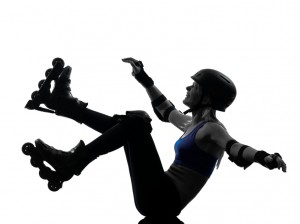
In this personal injury rollerblading case(Chabot v. Chaube,2014 BCSC 300) The claimant was not obliged to remove her inline skates to cross at a marked crosswalk but, having chosen to skate across the crosswalk, she was required to take reasonable precautions for her own safety considering her speed and visibility. Rollerblading within a marked crosswalk is not illegal in British Columbia, according to the Supreme Court, but in this case a “momentary lapse” caused this claimant to lose 10% of her $425,000 personal injury award.
In finding that the claimant shared fault, albeit only ten percent, the judge found that the claimant was travelling considerably quicker than a pedestrian walking. As Judge Brown explains,
[35] The law does not declare the plaintiff broke the law by skating across the crosswalk. Cyclists are obligated to dismount when they enter a crosswalk, see s. 183(1)(b) of theMotor Vehicle Act, R.S.B.C. 1996, c. 318. But the Motor Vehicle Act does not include roller blades in its definition of “cycle”, see s. 119(1) “cyclist”; they are pedestrians. Further, I appreciate inline skating is a popular way to get around in good weather. Some road skaters appear very adept and agile skaters. I accept the plaintiff was an experienced skater and that she knew how to stop properly on skates. She was not obliged to remove her skates to cross. But having chosen to skate across the crosswalk, she needed to take reasonable precautions for her own safety, commensurate with her speed and visibility of traffic beyond the stopped bus.
[36] As noted in Karran, “fault may vary from extremely careless conduct, by which the party shows a reckless indifference or disregard for the safety of person or property, whether his own or others, down to a momentary or minor lapse of care in conduct which, nevertheless, carries with it the risk of foreseeable harm.” I find the plaintiff’s conduct falls within the range of a momentary or minor lapse of conduct, which nevertheless, carries with it the risk of foreseeable harm. Based on this finding, and the circumstance that she was always within a marked crosswalk, I apportion 90% fault to the defendant and 10% to the plaintiff.
The judge found that the claimant suffered a serious shoulder injury as a result of the inline skating accident and accepted the realistic and substantial possibility that had the claimant’s shoulder not been impaired she could have pursued more diverse job opportunities. The personal injury award of $382,522.72, after reduction, can be summarized as follows:
| Pain and Suffering : |
$80,000 |
| Loss of homemaking capacity: |
$20,000 |
| Loss of past earnings: |
$31,807 |
| Loss of future earnings capacity: |
$280,000 |
| Future cost of care: |
$8,000 |
| Special damages: |
$5,218.25 |
| Reduction for contributory negligence: |
10% |
To get more facts about pedestrian and inline skating accident injury claims check out our pedestrian accident lawyer section.
Posted by Personal Injury Lawyer Mr. Renn A. Holness, B.A. LL.B.
